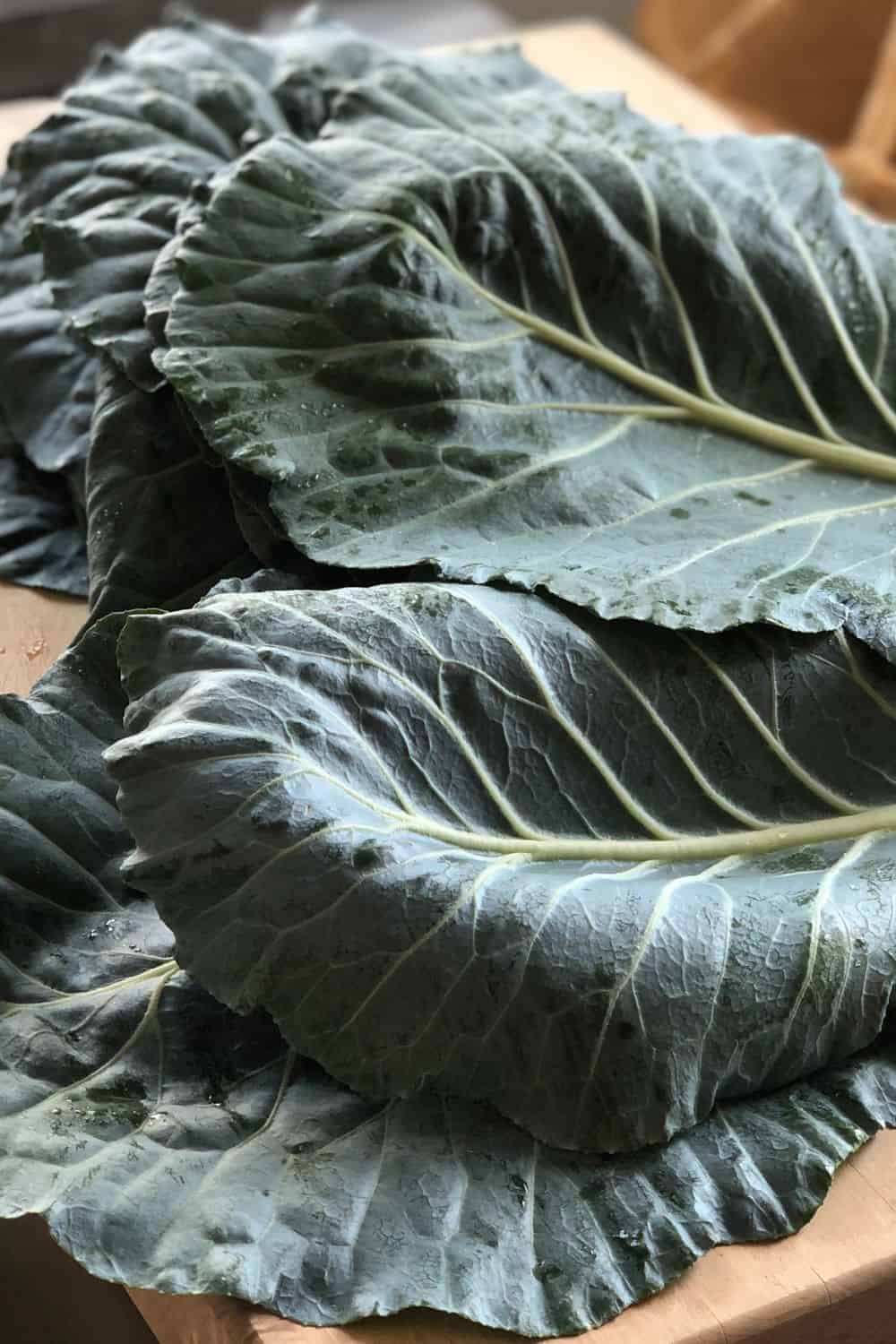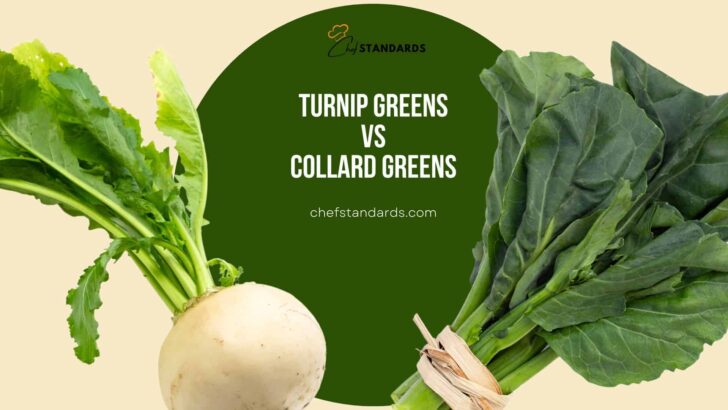They are not many people’s “cup of tea”, but it’s hard to imagine today’s cuisine without some leafy green veggies.
One of the most popular leafy greens is definitely turnip greens and, especially, collard greens. Since they hail from the same cabbage family and share many similarities, people find it difficult to distinguish between them.
However, there are differences between these two veggies, and they are presented through their appearance, taste, uses, nutrition, as well as some other minor things.
Although those differences are not huge, it is sometimes very important to know them, especially when choosing the right green ingredient for your next healthy meal.
[table id=41 /]
Turnip Greens vs Collard Greens: Overview
Before I head to the main part, I will just reveal a few most important facts about turnip greens and collard greens in order to provide you with a bigger picture of these two leafy green classics.
Turnip Greens

Turnip greens are actually the edible, leafy tops of the turnip plant, scientifically known as Brassica rapa.
Turnips are root vegetables that are best known for their bulbous roots, but the leaves are also well-appreciated for their versatility and nutritional value.
Turnips, and consequently turnip greens, are part of the broader Brassicaceae family. This family, also known as the mustard family or cabbage family, is a home of many familiar veggies, including mustard greens, cabbage, and collard greens.
However, mustard greens and cabbage belong to the same rapa species, while that’s not the case with collard greens.
Collard Greens

Collard greens, or simply collards, are a type of leafy green vegetable that is botanically classified as Brassica oleracea var. Viridis.
This vegetable that starts with C belongs to the broader species Brassica oleracea.
This oleracea species also include broccoli and kale, but not turnip greens. However, all of these are from the same family, the Brassicaceae family.
Due to the fact that they are part of the same family, they share many similarities, but since they are different species, they also have notable differences, which we will learn in detail below.
Turnip Greens vs Collard Greens: 4 Defining Differences

These were some of the core information about the classification of these two vegetables. Below, the key differences that will most likely influence your culinary choice, are addressed. So, let’s begin.
1. Appearance
At first sight, you may find it hard to distinguish between these two types of leafy greens. However, when you look at them more closely, the differences get clearer immediately.
First, collard green leaves are bigger in size, and they are even among the largest leaves found in the Brassica family. The size of turnip green leaves is typically bigger as they mature, but they still can not rival that of collard greens.
Turnip greens are also thinner and have a more delicate leaf texture when compared to collard greens. The leaves can be tender when young, but as they mature, they become slightly rougher and more fibrous.
Collard green leaves, on the other hand, are thick and have a waxy surface, which contributes to their durability, as well as their ability to tolerate longer cooking times.
Finally, the shape of these two is also slightly different. The leaves of turnip greens are typically deeply lobed or ruffled. In contrast, collard greens have large, broad leaves that are relatively flat.
2. Flavor
The flavor profile always plays a huge role, probably the most important one, when it comes to choosing between two similar types of food, in this case, veggies.
And indeed, turnip greens and collard greens do have distinct taste profiles. The flavor profile of turnips can be described as mild and earthy with a slight sweetness and bitter undertones.
However, turnip greens are known for their slightly sweeter, peppery taste. The bitterness is often mild.
Collard greens, on the other hand, have a more robust flavor, which is not everybody’s cup of tea, especially when they are raw. The taste of collard greens can also be described as somewhat cabbage-like, although not as bitter as cabbage.
Their flavor is similar to the flavor of kale and Swiss chard, so they are also interchangeable.
I also have to emphasize that age also influences the flavor profile, especially when it comes to turnip greens. Young turnip greens tend to be milder in flavor, while older leaves often have a stronger, more robust taste.
Similarly, the cooking process can change the flavor of both leaves, but more about that below.
3. Uses
Turnip greens and collard greens are quite similar when it comes to culinary uses, as they both can be steamed, sauteed, or roasted.
However, if you want to make a salad, your best option is to choose turnip greens as they are much more suitable for this purpose.
Aside from the fact that they are traditionally used in salads, they have a more subtle and sweeter flavor when raw. Collard greens have that robust flavor that does not do much for your taste buds.
But, when it comes to cooking, collard greens come into play. First, the cooking process is able to mellow down the bitterness of collard greens, leaving them with much more subtle flavors.
Aside from that, collard greens can withstand longer cooking times due to their sturdy texture. They are therefore often simmered or braised for an extended period to soften their leaves and develop rich flavors.
Also, it is best to cook them with ingredients like bacon or smoked meats to infuse them with savory notes, as this can create a really nice flavor profile.
They can also be a great side for sandwiches, as their crunchy texture pairs perfectly well with meats, cheeses, and other sandwich fillings.
You can also cook turnip greens, but since they are cooked for shorter periods, it is best to saute or stir-fry them. You can also add them to soups, stews, and stir-fries as a flavorful addition.
When cooked, you can use these two leafy greens interchangeably. However, I wouldn’t recommend you use collard greens instead of turnip greens in salads because you will end up with quite a bitter salad.
4. Nutrition
Like any other leafy veggie, both turnip greens and collard greens are healthy ingredients. They also have similar nutrient profiles, but there are a few notable differences between the two.
First, both types of veggies are not very dense in nutrients, as they contain a lot of water. However, collard greens are a little denser, since they have less water.
They are both low in calories, but turnip greens are lower, i.e. a 100g serving has 19 calories, compared to collard greens which have 33 calories.
Collard greens also contain more carbs. 5.6g of carbs are found in a 100g serving of collard greens, while turnip greens offer around 2.81g. Turnip greens are also a better source of dietary fiber.
Again, when it comes to protein, collard greens take the trophy with 2.7g per 100g serving, compared to turnip greens at 1.36g.
The amount of fats is also higher in collard greens, but the overall amount in both types of veggies is very low, i.e. less than 1g per 100g serving.
Finally, when it comes to vitamins and minerals, collard greens are the ultimate winner again.
Compared to turnip greens, they have four times more vitamin B1, three times more vitamin B6, and overall more vitamins A, C, and K, as well as B2 and B3.
Turnip greens are only higher in vitamin B9 (folate) and vitamin E.
When it comes to minerals, turnip greens provide more selenium, iron, copper, and potassium. Collard greens, on the other hand, are a better source of calcium, manganese, and phosphorus.
Few Additional Information About Turnip and Collard Greens
These were the most important differences between turnip greens and collard greens, especially when it comes to culinary uses. However, I want to share some additional information about the two, which are also quite important.
• USDA Plant Hardiness Zones: In fall and throughout winter, turnip greens are planted in USDA zones 9 and 10.
On the other hand, collard greens are grown in USDA zones 8 and above.
• Growth Season and Timing: Both types are cool-season vegetables. The difference lies in the fact that collard greens are more cold- and frost-tolerant.
They are both planted in spring and summer, but the main difference is that turnip greens grow faster than collard greens.
Turnip greens can therefore be harvested in around 40 days, while collard greens take 60 to 75 days to harvest.
• Price and Availability: Since they are the staple in Southern cuisine in the US, collard greens tend to be more widely available.
However, when it comes to price, there are no major differences, although the exact price may vary depending on the location, packaging, or brand.
You can buy both for 0.98 cents per bunch at Walmart; 0.99 cents at Shoprite; and $2.99 at Hannaford.
• Shelf Life and Storage: Both fresh turnip greens and collard greens can last up to 5-7 days when stored properly in the fridge.
To store them the right way, it is essential to avoid rinsing before storing them; place them into a food storage bag or airtight container; put them in a crisper drawer.
When properly stored in the freezer, turnip greens can last up to 8-12 months, while collard greens can stay good for about 10-12 months.
• Spoilage Signs: Both greens share the same signs of spoilage. The signs are:
1. Turning soft
2. Turning slimy
3. Wilting
4. Discoloration
5. Foul Odor


